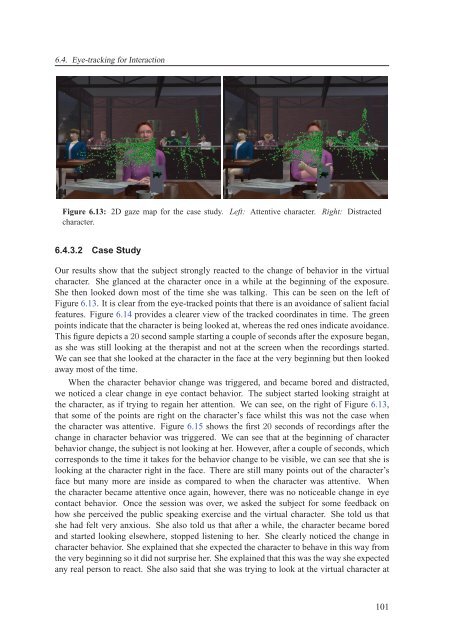Texte intégral / Full text (pdf, 20 MiB) - Infoscience - EPFL
Texte intégral / Full text (pdf, 20 MiB) - Infoscience - EPFL
Texte intégral / Full text (pdf, 20 MiB) - Infoscience - EPFL
You also want an ePaper? Increase the reach of your titles
YUMPU automatically turns print PDFs into web optimized ePapers that Google loves.
6.4. Eye-tracking for Interaction<br />
Figure 6.13: 2D gaze map for the case study. Left: Attentive character. Right: Distracted<br />
character.<br />
6.4.3.2 Case Study<br />
Our results show that the subject strongly reacted to the change of behavior in the virtual<br />
character. She glanced at the character once in a while at the beginning of the exposure.<br />
She then looked down most of the time she was talking. This can be seen on the left of<br />
Figure 6.13. It is clear from the eye-tracked points that there is an avoidance of salient facial<br />
features. Figure 6.14 provides a clearer view of the tracked coordinates in time. The green<br />
points indicate that the character is being looked at, whereas the red ones indicate avoidance.<br />
This figure depicts a <strong>20</strong> second sample starting a couple of seconds after the exposure began,<br />
as she was still looking at the therapist and not at the screen when the recordings started.<br />
We can see that she looked at the character in the face at the very beginning but then looked<br />
away most of the time.<br />
When the character behavior change was triggered, and became bored and distracted,<br />
we noticed a clear change in eye contact behavior. The subject started looking straight at<br />
the character, as if trying to regain her attention. We can see, on the right of Figure 6.13,<br />
that some of the points are right on the character’s face whilst this was not the case when<br />
the character was attentive. Figure 6.15 shows the first <strong>20</strong> seconds of recordings after the<br />
change in character behavior was triggered. We can see that at the beginning of character<br />
behavior change, the subject is not looking at her. However, after a couple of seconds, which<br />
corresponds to the time it takes for the behavior change to be visible, we can see that she is<br />
looking at the character right in the face. There are still many points out of the character’s<br />
face but many more are inside as compared to when the character was attentive. When<br />
the character became attentive once again, however, there was no noticeable change in eye<br />
contact behavior. Once the session was over, we asked the subject for some feedback on<br />
how she perceived the public speaking exercise and the virtual character. She told us that<br />
she had felt very anxious. She also told us that after a while, the character became bored<br />
and started looking elsewhere, stopped listening to her. She clearly noticed the change in<br />
character behavior. She explained that she expected the character to behave in this way from<br />
the very beginning so it did not surprise her. She explained that this was the way she expected<br />
any real person to react. She also said that she was trying to look at the virtual character at<br />
101

















